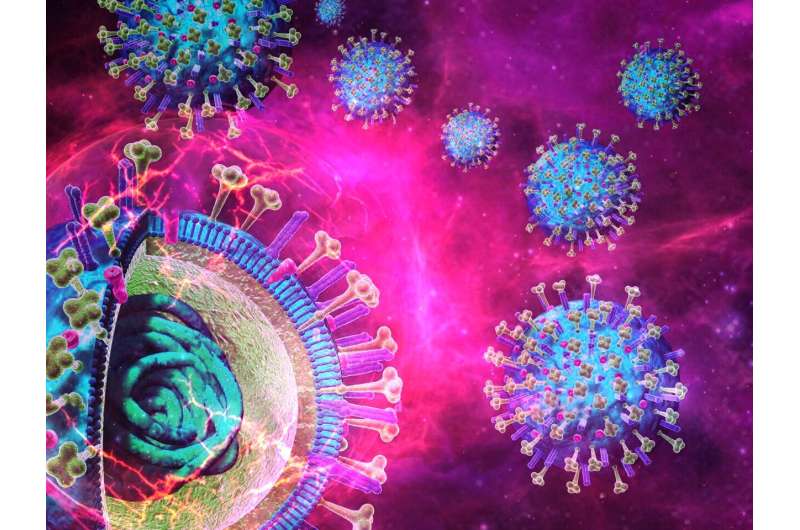This article has been reviewed according to Science X's editorial process and policies. Editors have highlighted the following attributes while ensuring the content's credibility:
fact-checked
peer-reviewed publication
trusted source
proofread
Method for improving seasonal flu vaccines also aids pandemic prediction

Improving the seasonal influenza vaccine and public health specialists' ability to predict pandemic potential in new flu strains may be possible, due to new findings from scientists at St. Jude Children's Research Hospital. The key is the stability of a viral protein that gains entry into human cells. The findings were published today in Science Advances.
"We found that the protein flu viruses use to enter cells, hemagglutinin, needs to be relatively stable and resistant to acid in an effective H3N2 flu vaccine," said senior and co-corresponding author Charles Russell, Ph.D., St. Jude Department of Infectious Diseases. "We found a mutation in hemagglutinin that makes the virus grow better in eggs also causes a mismatch in the vaccine. The mutation makes the virus unstable and makes it look less human-like."
The H3N2 virus is a subtype of Influenza A and is one of the culprits behind the seasonal flu. Many flu vaccines are made by growing the virus in chicken eggs, but the virus can gain mutations during that process. Some of those changes, like the one uncovered by the St. Jude group, make the vaccine less effective in generating the ideal immune response. At the same time, other mutations have more beneficial impacts.
"We also found a different mutation in egg adaptation that doesn't destabilize the hemagglutinin or make it less human-like," Russell said. "That mutation prevented the emergence of the destabilizing mutant. Going forward, incorporating this protective mutation or otherwise assuring hemagglutinin stability may help maintain vaccine efficacy."
While egg-adaptive mutations are a well-known weakness in many current flu vaccine pipelines, scientists currently do not consider viral protein stability when assessing flu strains to include in the annual vaccine. This study suggests that testing flu strains' hemagglutinin for an antigenic match to circulating viruses, and then including only those with higher stability, may improve the vaccine by preventing the incorporation of strains with unstable proteins.
Predicting influenza pandemic potential
The scientists also found that hemagglutinin stability could be measured to better predict the pandemic potential of novel flu strains. Flu viruses with the unstable protein could not transmit in the air between ferrets, a model used to infer likely properties in humans. Moreover, viruses with the more stable protein version had a high airborne transmission rate.
"The top of the lungs and nose, called the upper respiratory tract, is mildly acidic," Russell said. "The viral protein needs to be able to resist mild acid when it's outside of the cell in the respiratory tract. That's why the stable hemagglutinin improves transmission."
Hemagglutinin is like a mousetrap, ready to strike and poke into a human cell when exposed to enough acid. If unstable proteins trigger too early in the mildly acidic lung environment, the virus can't enter any cells.
But if the viral protein is too stable, it can also be a problem for the virus. Previous research showed that too much stability delays the virus from infecting new cells. The St. Jude group's work shows that a pandemic flu virus must fall in the stability "sweet spot"—stable enough to make it through the mildly acidic lung environment but unstable enough to infect quickly when they reach the appropriate part of cells.
Both the Centers for Disease Control (CDC) and World Health Organization (WHO) monitor for potential pandemic flu viruses worldwide. They currently watch for well-known mutations that switch an avian flu virus to one that can enter humans, including those that change the receptors to which hemagglutinin can bind. This study adds to a growing body of work characterizing the other changes needed for an avian virus to jump into humans.
"In addition to changes in receptor binding, there are a few other properties that we know that have to change too, and they're not currently well accounted for in risk assessment, due to a lack of feasibility. But for hemagglutinin stability, it's a simple concept to expose it to different acidities and measure the remaining infectivity of a virus," said Russell.
Therefore, the study's results suggest that by incorporating a simple experiment testing hemagglutinin stability, scientists may be able to better assess the pandemic potential risk of novel influenza viruses.
The study's first author is Meng Hu, and the co-corresponding author is Richard Webby, both of St. Jude Children's Research Hospital. The other authors are Christina Kackos, Balaji Banoth, Chet Raj Ojha, Jeremy Jones and Shaohua Lei of St. Jude and Lei Li, Weill Cornell Medicine.
More information: Meng Hu et al, Hemagglutinin destabilization in H3N2 vaccine reference viruses skews antigenicity and prevents airborne transmission in ferrets, Science Advances (2023). DOI: 10.1126/sciadv.adf5182. www.science.org/doi/10.1126/sciadv.adf5182



















